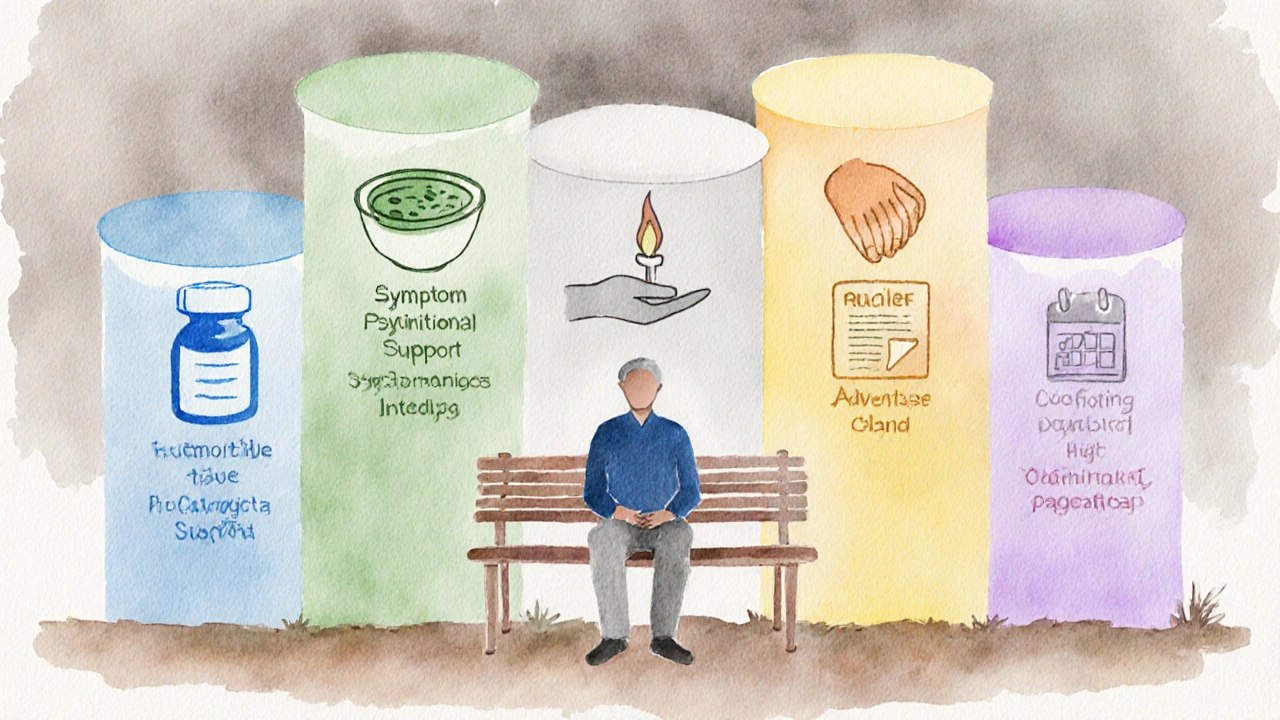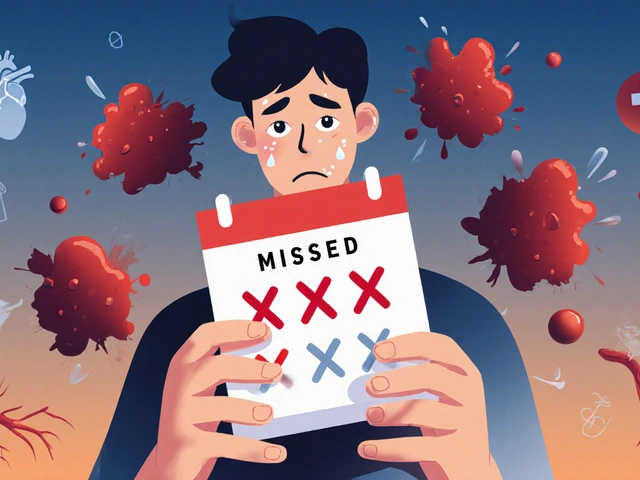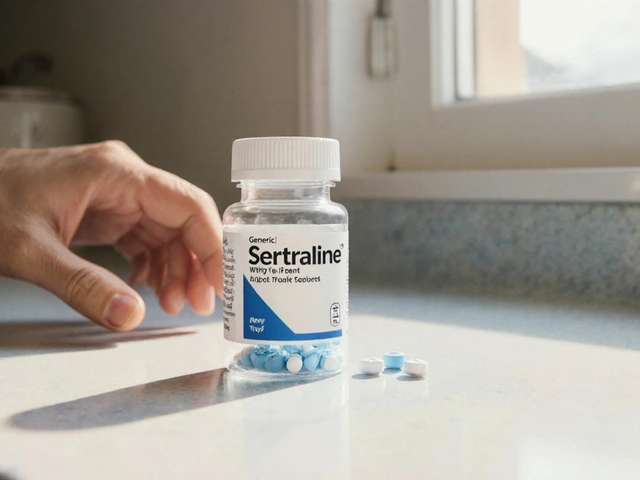Palliative Care Integration Timeline
Diagnosis (Stage I-III)
Initial symptom assessment, introduce palliative team, discuss goals
Oncologist & Palliative PhysicianMid-treatment
Weekly pain and nausea check-ins, nutritional counseling
Nurse Specialist & DietitianProgressive Disease (Stage IV)
Intensive pain control, psychosocial support, advance care planning
Multidisciplinary TeamEnd-of-life Transition
Hospice referral if appropriate, bereavement services
Social Worker & Hospice Coordinator- Improved survival rates (2-4 months)
- Reduced hospital admissions
- Better symptom control
- Enhanced quality of life
- Decreased emergency department visits
Recommended Actions for This Stage
When a cancer diagnosis lands on a patient’s doorstep, the first instinct is to chase cure‑focused therapies like surgery, chemo or radiotherapy. But the reality is that many patients live with advanced disease for months or years, dealing with pain, fatigue, nausea and emotional turmoil. That’s where palliative care steps in - not as a last‑ditch effort, but as a parallel service that works hand‑in‑hand with curative treatments to keep people as comfortable and autonomous as possible.
Key Takeaways
- Palliative care is evidence‑based, multidisciplinary support that begins at diagnosis, not only at end‑of‑life.
- Early integration improves survival, reduces hospital admissions, and enhances quality of life for carcinoma patients.
- Core components include pain control, symptom management, psychosocial support, nutrition, and advance care planning.
- A coordinated team-oncologists, palliative specialists, nurses, social workers, and pharmacists-delivers seamless care.
- Patients and families benefit from clear communication, realistic goal‑setting, and a personalized care roadmap.
Understanding Palliative Care
Palliative care is a specialized medical approach that focuses on relieving suffering and improving the overall well‑being of people facing serious illness. It addresses physical symptoms, emotional distress, spiritual concerns, and social challenges. Unlike hospice, which is limited to the last months of life, palliative care can be offered at any stage of cancer, alongside disease‑targeting treatments.
Why Palliative Care Matters in Carcinoma Treatment
Carcinoma is a type of cancer that originates in epithelial cells, accounting for the majority of solid tumours such as breast, lung, colon and prostate cancers. These tumours often cause intense pain, cachexia, and side‑effects from chemo or radiotherapy. Studies from 2023‑2024 show that patients who receive early palliative input have a 20% lower risk of emergency department visits and a modest survival boost of 2-4 months compared with standard oncology care alone.

Core Components of Palliative Oncology
Effective palliative support rests on six interlocking pillars. Each pillar is delivered by a specific professional group, creating a truly multidisciplinary effort.
- Symptom Management: Pain, nausea, dyspnea, and fatigue are tackled with opioids, anti‑emetics, and rehabilitative exercises. Pain management uses WHO’s three‑step ladder, tailored to the patient’s pain intensity.
- Psychological Support: Anxiety, depression, and existential angst are addressed through counseling, cognitive‑behavioral therapy, and sometimes medication. Mental health professionals integrate coping strategies directly into the treatment plan.
- Nutritional Care: Cachexia is common in advanced carcinoma. Dietitians design high‑calorie, protein‑rich menus and may prescribe oral nutrition supplements.
- Spiritual & Social Care: Chaplains, social workers, and volunteer groups help patients find meaning and maintain connections with family and community.
- Advance Care Planning: Patients clarify their wishes about life‑sustaining treatments, resuscitation, and preferred place of care. Advance care planning documents become legal guides for future decisions.
- Care Coordination: A dedicated case manager ensures appointments, medication reconciliations, and communication between oncology, radiology, and palliative teams remain seamless.
Integrating Palliative Care Early: A Practical Timeline
Research demonstrates that waiting until the disease is terminal negates many benefits. Below is a simple timeline that clinicians can follow.
| Stage | Key Actions | Responsible Professional |
|---|---|---|
| Diagnosis (Stage I‑III) | Initial symptom assessment, introduce palliative team, discuss goals | Oncologist & Palliative Physician |
| Mid‑treatment (Chemotherapy/Radiotherapy) | Weekly pain and nausea check‑ins, nutritional counseling | Nurse Specialist & Dietitian |
| Progressive disease (Stage IV) | Intensive pain control, psychosocial support, advance care planning | Multidisciplinary Team |
| End‑of‑life transition | Hospice referral if appropriate, bereavement services | Social Worker & Hospice Coordinator |
Common Misconceptions About Palliative Care
- Myth: It means “giving up.”
Reality: It runs parallel to curative treatment and aims to keep patients strong enough for ongoing therapy. - Myth: Only for the last weeks of life.
Reality: Early referral has been linked to longer survival in several randomized trials. - Myth: It’s only about pain relief.
Reality: It covers emotional, spiritual, and practical needs, too.

Practical Steps for Patients and Providers
Both sides can take concrete actions to make palliative care a seamless part of the cancer journey.
- Ask the right questions: "When will my pain be reassessed?" or "What are my options if my disease progresses?"
- Document wishes early: Complete an advance directive before fatigue sets in.
- Use a symptom diary: Track pain scores, nausea episodes, and mood daily; share with the care team.
- Engage family: Invite caregivers to appointments so they understand medication plans and warning signs.
- Leverage technology: Tele‑palliative visits reduce travel burden and allow rapid medication adjustments.
Future Directions: Research and Innovation
Emerging trials are testing combined immunotherapy‑palliative protocols, aiming to reduce inflammation‑driven fatigue. Digital health platforms now integrate patient‑reported outcomes directly into electronic medical records, giving clinicians real‑time alerts for worsening symptoms.
Additionally, the UK’s National Health Service is piloting “Palliative Care Hubs” within major cancer centres, ensuring every tumour board includes a palliative physician. Early data suggest a 15% drop in unplanned hospital admissions.
Frequently Asked Questions
Is palliative care only for terminal cancer patients?
No. Palliative care can start at diagnosis and runs alongside curative treatments. Early involvement often improves survival and reduces side‑effects.
Will my oncologist still guide my treatment if I see a palliative team?
Absolutely. The palliative specialist collaborates with your oncologist, sharing updates and adjusting symptom‑relief plans without altering the core cancer regimen.
How are pain medications managed to avoid addiction?
Pain is treated using the WHO ladder, starting with non‑opioids, moving to weak opioids, then strong opioids if needed. Doses are carefully titrated, and patients are monitored regularly for signs of misuse.
Can palliative care help with emotional distress?
Yes. Licensed counselors, psychologists, and spiritual care providers address anxiety, depression, and existential worries, often using brief therapies that fit busy oncology schedules.
What happens if my disease progresses despite treatment?
The palliative team revisits goals, updates the advance care plan, and may shift focus from disease‑targeted therapy to comfort‑oriented interventions, ensuring the patient’s values drive every decision.







Rebecca Mikell
October 8, 2025 AT 20:03